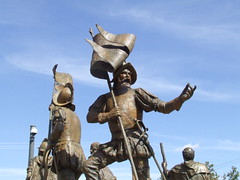After Columbus, the colonization of America was led by a series of warrior-explorers called Conquistadors, says Wikipedia.
The Spanish forces exploited the rivalries between competing local peoples and states, some of which were only too willing to form alliances with the Spanish in order to defeat their more-powerful enemies, such as the Aztecs or Incas—a tactic that would be extensively used by later European colonial powers.
The Spanish conquest was also facilitated by the spread of diseases (e.g. smallpox) common in Europe but unknown in the New World, which decimated the native American populations.[14]
This caused a labour shortage and so the colonists informally and gradually, at first, initiated the Atlantic slave trade.
The Atlantic slave trade, also known as the transatlantic slave trade, was the trading, primarily of African people, to the colonies of the New World that occurred in and around the Atlantic Ocean. It lasted from the 16th to the 19th centuries.
Most enslaved people were shipped from West Africa and Central Africa and taken to North and South America[1] to work as unpaid labor on sugar, coffee, cocoa and cotton plantations, in gold and silver mines, in rice fields, or in houses to work as servants.
The shippers were, in order of scale, the Portuguese (and Brazilians), the English, the French, the Spaniards, the Dutch, and the North Americans.[1]
Enslaved people were generally obtained through coastal trading with Africans, though some were captured by European slave traders through raids and kidnapping.[2][3] Most contemporary historians estimate that between 9.4 and 12 million[4][5] Africans arrived in the New World.
skip to main |
skip to sidebar
For students and parents who love education and exploration of the social sciences . . .
Search This Blog
Followers
Blog Archive
-
▼
2009
(379)
-
▼
October
(49)
- No school on Fri in Caddo-Bossier, says KTBS news
- The movie "Master and Commander; Far Side of the W...
- Brazil: Portuguese-speaking, multi-ethnic land of ...
- Review questions on Brazil
- Brazil: comparison research on a vibrant South Ame...
- Magnet Drama Day is Friday
- Indie work: comparing successful Mexicans Frida Ka...
- South America in Upfront magazine: the top 5 nations
- Mexico: the Tenochtitlan Quiz
- What we shall be singing on Dia de los Muertos: "l...
- The Spanish Empire project on Wed, Oct 21
- From Mexico to Spain: follow the money
- How the work of the Conquistadors lead to the Atla...
- The feathered serpent: Quetzalcoatl
- Mesoamerican technology: the remarkable Aztec cale...
- Capital of the Aztecs: Tenochtitlan
- The Aztec glyph for movement
- Aztecan divine bird: the Resplendent Quetzal
- Mon: The Blue Planet / Coral seas
- Barracuda & shark
- Developments credited to the Aztecs
- Hecho en Mexico: Chiclets
- Ancient Mexican craft: papel picado
- Calaveros, calacos, catrina, ofrendas, papel picad...
- Map quiz, Mexico, next Thurs: 12 items
- Money for Myrtles project up to $203.56 in donatio...
- Semester Projects: Social Studies Fair Team & Topi...
- Cmh13.com: another way to connect with your classm...
- Mexico project Uno
- Genealogy and America: the roots of Michelle LaVau...
- Lungi: a man-skirt retained from the ancient days ...
- We measure things oddly; we look at feet and miles...
- Maple Leaf Quiz / Geography Open Notes review # 6
- Mexico City profile from About.com
- The geography class Open Notes quiz is based on we...
- Dancing house Gecko
- Salmon: global resource that is important to Canad...
- Vancouver to Quebec: a review of Canada
- Three cacophonous cities / geography quiz 5
- Quiz on Th, Oct 8: map of Canada and open notes qu...
- Brief reports on GoogleDocs comparing one facet of...
- Oct 5 / this week: Canada vs Mexico
- Red River Revel: Sat, Oct 3, to Sat, Oct 10
- Vieux Montreal has been called Petit Paris
- Canada's most populous city: Toronto
- The high-tech, Asian and diverse Canadian city on ...
- Famous Canadians in New Orleans' French Quarter: B...
- The simplified Regional US: what is the Midwest?
- The Ethicist: a columnist answers questions about ...
-
▼
October
(49)

